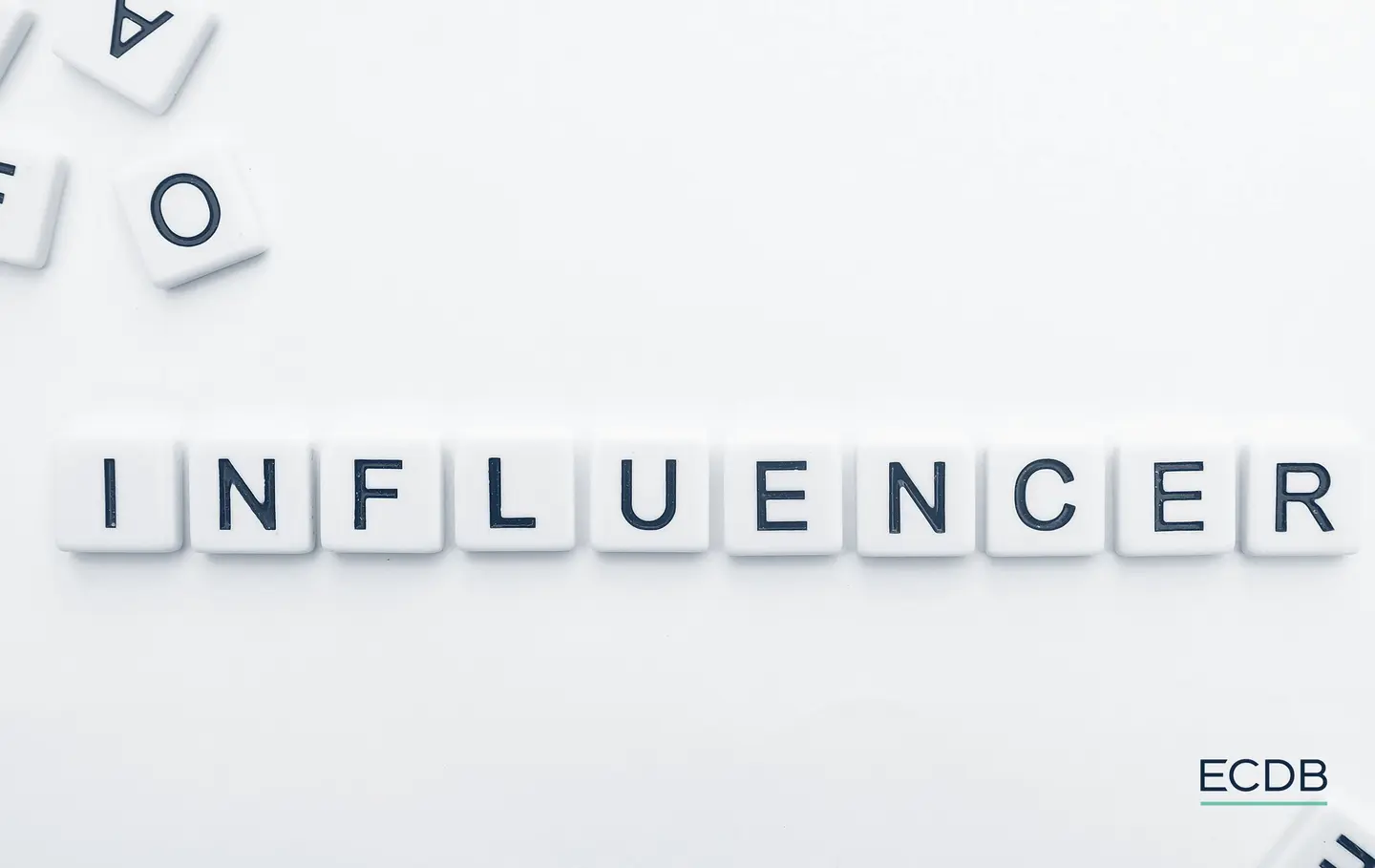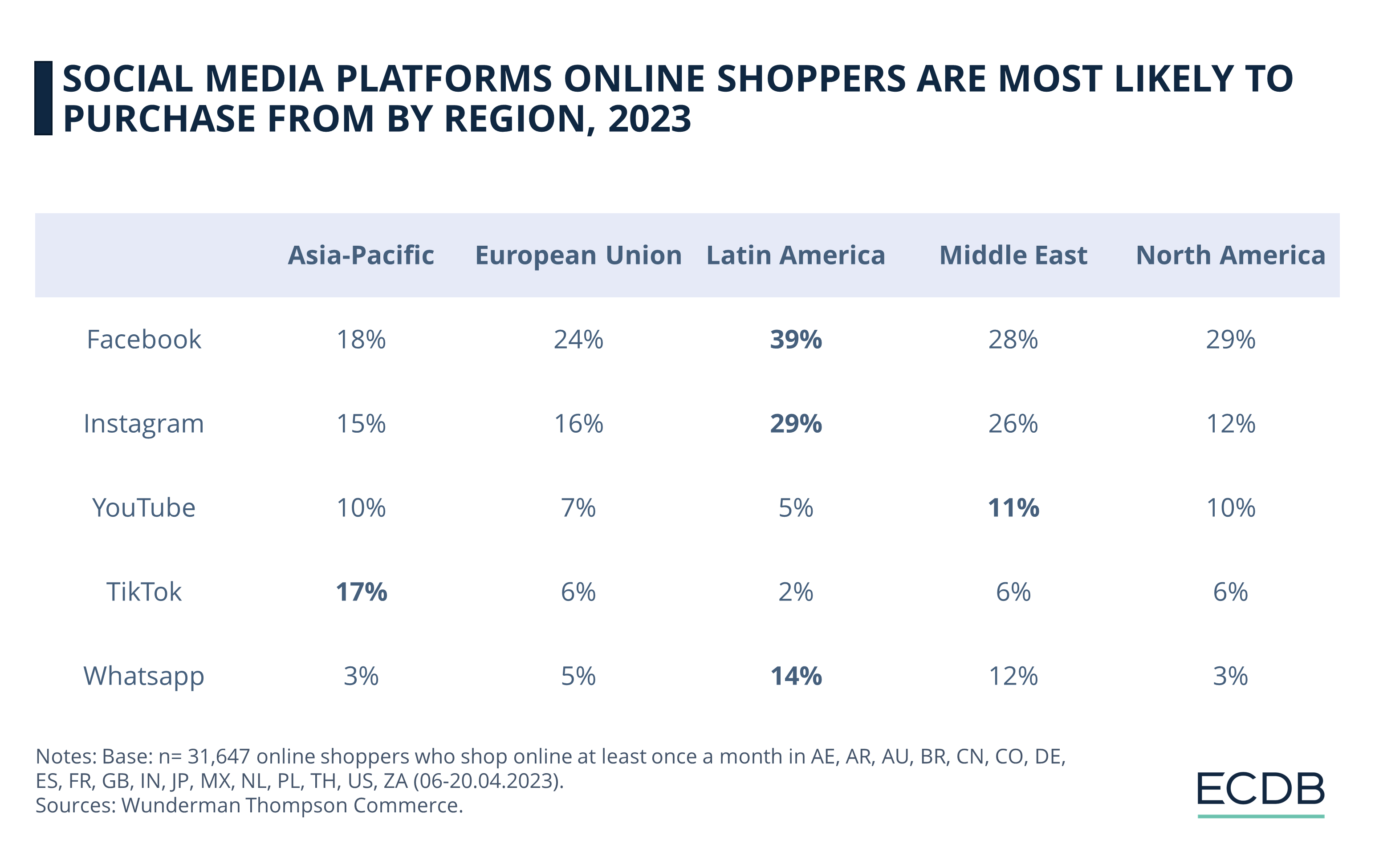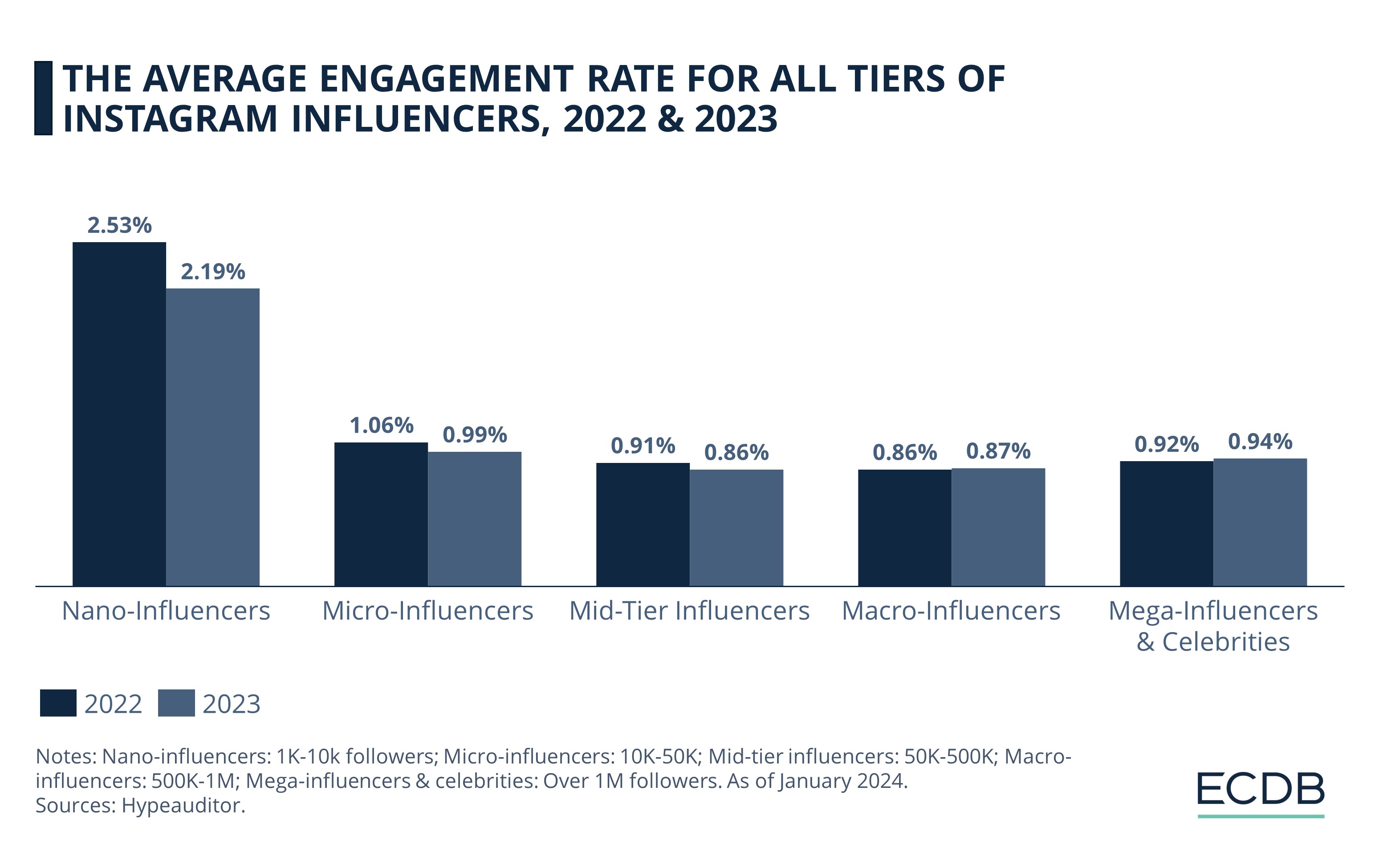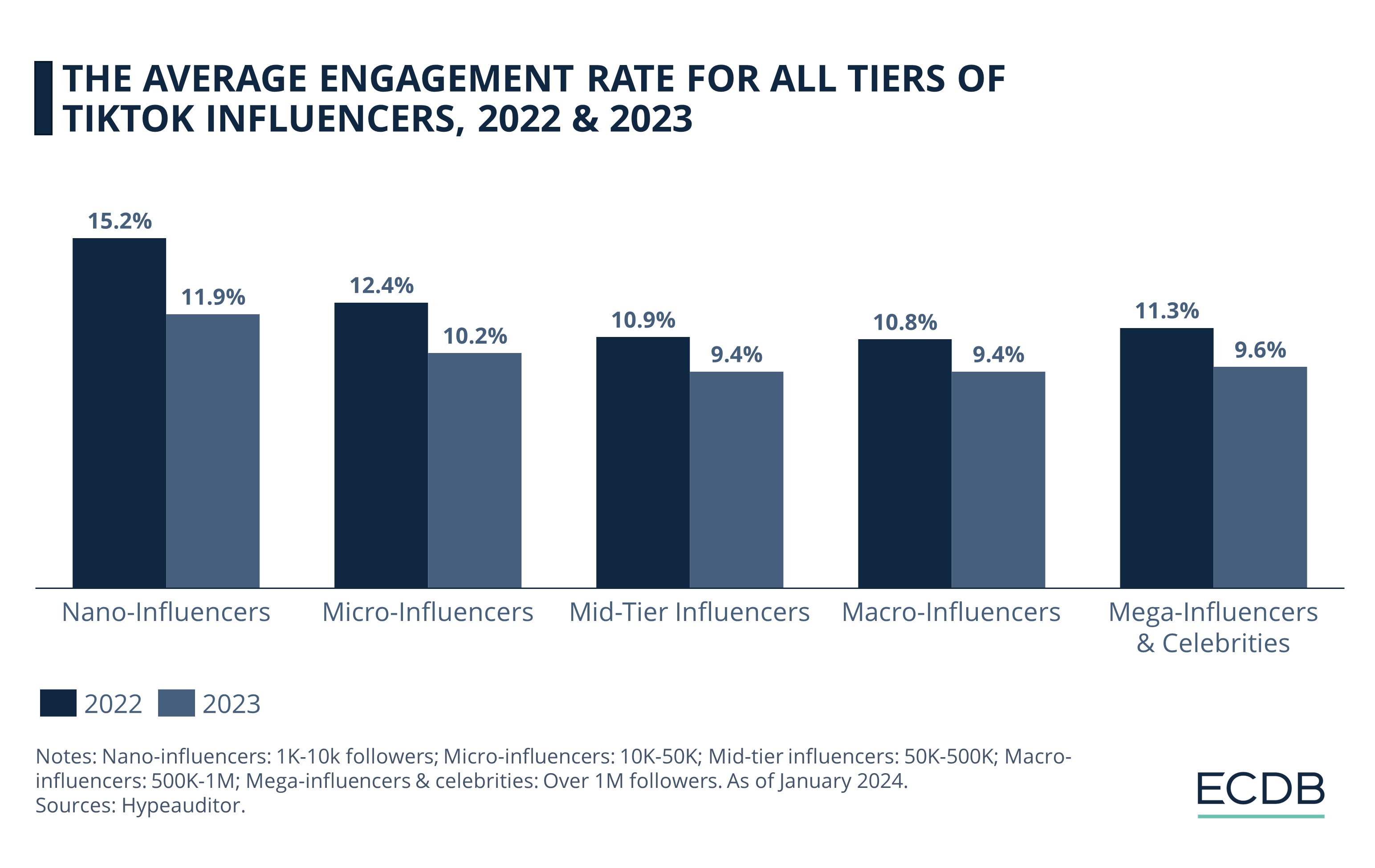eCommerce: Social Commerce
Influencer Marketing in Social Commerce: Instagram and TikTok Influencers, Engagement Rate, Strategy
Influencer marketing is a growing trend, but partnering with the right influencer tier determines eCommerce success. Learn about influencer tiers on Instagram and TikTok, and how their engagement levels with platform users can accelerate social commerce sales.
Article by Nitika Lobo | April 16, 2024Download
Coming soon
Share

Influencer Marketing on Instagram and TikTok: Key Insights
Instagram and TikTok’s popularity by region: Compared to other regions, Instagram’s use for social commerce is highest in Latin America, whereas TikTok’s biggest audience is in Asia Pacific. However, in all world regions, Facebook remains the top platform for social shopping.
Engagement rates by influencer tier: On both Instagram and TikTok, nano-influencers, with less than 10,000 followers, have the highest engagement rates. Mega- and macro-influencers (between half a million and one million followers) have lower engagement.
Social commerce through influencers: Partnering with nano-influencers is a cost-effective way for brands to reach a niche target audience. Mega- and macro-influencers are suitable for brands willing to spend more to reach a very large audience fast.
Social commerce has seen a rapid expansion in recent years. Through it, consumers can discover and purchase products without having to leave a social media app.
For social commerce, Instagram and TikTok influencers are key figures of interest. They connect with their large audience while integrating product promotions in their content. Knowing the right influencer tier to collaborate with can help brands increase their online sales.
Where are Instagram and TikTok most preferred for social commerce? And which influencer tiers are most successful in terms of engagement?
Social Commerce: Facebook is the Leading Platform in Most World Regions
The social commerce market generated revenues of US$900 billion in 2023 and is expected to grow beyond US$6 trillion by 2030. However, the adoption rates of social commerce differ worldwide, and so do the preferred platforms.
According to a report by Wunderman Thomson, while Facebook is still the leading social commerce platform, Instagram and TikTok are emerging as its competitors in different world regions.

Facebook is the top choice for social commerce in Latin America, with 39% of shoppers most likely to purchase products from it. It remains most used in all other regions as well, although its adoption elsewhere is relatively low. This is likely because the adoption of social commerce is comparatively high in Latin America, which leads among all other world regions.
Instagram also finds its largest social commerce audience in Latin America. The region has the highest share of Instagram shoppers (29%), just ten percentage points behind Facebook. Instagram is similarly popular in the Middle East (26%), although not so preferred in North America (12%).
TikTok, on the other hand, does not have very high shares of online shoppers in most world regions. But in Asia Pacific, it is head-to-head with Facebook. At 17%, it draws its highest share of social shoppers in APAC, with Facebook leading by a slight margin at 18%.
While Instagram or TikTok do not have high adoption rates in APAC, social commerce is nonetheless an established trend. In countries like China, regional platforms remain highly popular amongst consumers for social commerce practices like group buying and live shopping,
WhatsApp and YouTube are comparatively less popular for social commerce. Latin America (14%) is the top social commerce market for WhatsApp, and the Middle East for YouTube (11%).
As Instagram and TikTok gain popularity in social commerce, it becomes important for business to look at how to use them efficiently. A critical marketing component on both these platforms is influencers: they help engage a large target demographic to boost online sales.
Influencer Tiers on Instagram and TikTok
Though influencers are useful for social commerce, not all influencers are equally effective. A profitable social commerce strategy requires business collaborations with the right influencer tier.
HypeAuditor segments influencers into five main groups based on their follower count. The influencer tiers comprise:
Nano-influencers: 1K - 10k followers
Micro-influencers: 10K - 50K followers
Mid-tier influencers: 50K - 500K followers
Macro-influencers: 500K - 1M followers
Mega-influencers & celebrities: Over 1M followers
Each influencer tier performs differently on Instagram and TikTok, as each has a different audience base and engagement rate.
Instagram: Nano-Influencers Have the Highest Engagement Rate
According to Social Pilot, over 200 million businesses use Instagram to promote and sell their products. Moreover, nearly 49% of Instagram users utilize the platform for researching new products, while 50% say that they take action after they come across a product on Instagram.
A look at the engagement rates of influencer tiers on Instagram shows that influencer accounts with the highest engagement are also the smallest. This means that the accounts with the smallest share of followers get more interaction – such as likes, comments, shares, and clicks per post.

According to HypeAuditor, nano-influencers – with follower shares between 1,000 and 10,000 – make up for more than three-quarters of all influencers (76.8%) on Instagram. They also drive the highest engagement.
In 2023, nano-influencers’ engagement rate (2.2%) dropped compared to 2022 (2.5%), but this tier’s domination over others in terms of engagement rate continues. This suggests that on Instagram, users interact more with small accounts, where they may feel a sense of relatability with the influencer.
The engagement rates for larger accounts – macro-influencers and mega influencers, each with between half a million and one million followers – rose slightly since 2022. However, they still hover below 1%, indicating that the bigger the following, the less the audience interacts with the account.
While the numbers for large accounts may seem low, to put things into perspective, a nano-influencer with 10,000 followers who interacts with 2.5 people on average gets around 250 engagements. For a mega influencer with 1,000,000 followers, 1% still translates into 10,000 engagements.
The source also reveals that the average engagement rate for Instagram brand accounts was 0.5% in 2023 — three times below the average engagement rate for influencer accounts (1.85%). This is a helpful clue for businesses to include influencers in their marketing strategy, as they have much higher engagement levels than a typical business account.
TikTok: Nano-Influencers and Micro-Influencers Have Highest Engagement
TikTok has 1.2 billion monthly active users, most of whom are between the ages of 18 and 24. In 2023, it became the first-ever app to cross US$1 billion in consumer spending in a single quarter, thus emerging as a goldmine for brands looking to tap into the Gen Z market.
When looking at the TikTok influencer base, the same phenomenon as for Instagram is observed.
At 11.9% in 2023, nano-influencers had the highest engagement rates on TikTok as well. The engagement rate dipped by over 3 percentage points compared to 2022 (15.2%), but it still maintains a lead over other tiers.

Micro-influencers are not too far behind nano-influencers on TikTok, securing an engagement rate of 10.2% in 2023. Mid-tier, macro- and mega-influencers each have similar levels of engagement – between 9.4% and 9.6%.
The data also reveals another trend: no matter the influencer tier, TikTok influencers have much higher engagement levels than those on Instagram.
TikTok’s appeal lies in its unique video content, known as reels, and its highly interactive viral challenges. Although Meta-owned platforms such as Instagram and Facebook have now also borrowed the reel format, TikTok is pushing harder to integrate social commerce, particularly influencer marketing, within its platform.
TikTok Shop, an eCommerce platform that brings together merchants and influencers, was launched in September 2023. Retailers can set up a Shopping Tab, which functions as their eCommerce storefront on TikTok. As for customers, through TikTok, they can discover products of their interest, buy them and check out – all while staying within the app.
Influencers can now also experiment with new features, such as long-form video. This helps them create better shoppable videos, where they may integrate product promotions and tailor a more immersive social commerce experience for their followers. More recently, TikTok has also launched a Carousel function, which enables users to post pictures to garner higher views and interactions.
How to Make the Most of Influencers Marketing on Instagram and TikTok
To maximize the impact of influencer collaborations on Instagram and TikTok, businesses can utilize the below findings:
There are different tiers of influencers on Instagram and TikTok, ranging from nano to mega-influencers. The target audience, engagement goals, and budget are important aspects to consider when selecting the influencer tier to partner with.
Businesses intending to reach a niche demographic can partner with nano-influencers as they are able to forge more authentic connections with their audience and achieve higher levels of engagement.
Working with smaller accounts is also more cost-effective compared to accounts with a bigger reach. This is a plus point for brands with a limited budget.
For businesses aiming to reach a massive audience and improve brand visibility faster, collaborating with large accounts, such as macro- and mega-influencers, may be beneficial. However, they must set aside a higher budget to do so.
Influencer Marketing: Closing Remarks
Instagram and TikTok both offer influencer marketing opportunities for businesses that aim to increase online sales through social commerce. Instagram is estimated to be the top platform for influencer marketing in the U.S., but reports suggest that half the marketers are still not using TikTok to engage online shoppers. This is a lost opportunity since audience engagement levels are much higher on TikTok.
Data also shows that compared to 2022, influencer engagement rates on both Instagram and TikTok declined in 2023. This is likely due to the increase in the number of content creators and the changing algorithms on both these platforms. Going forward, influencers will have to modify their strategy in line with the algorithms to maintain or increase their engagement levels.
Sources: Social Pilot: 1, 2; Business of Apps, Modern Retail.

Click here for
more relevant insights from
our partner Mastercard.
Related insights
Deep Dive
The Global B2B eCommerce Market: Why It Is Beneficial to Sell to Other Businesses
The Global B2B eCommerce Market: Why It Is Beneficial to Sell to Other Businesses
Deep Dive
Why Did Amazon Fail in China: Local Competition Defeats the Retail Giant
Why Did Amazon Fail in China: Local Competition Defeats the Retail Giant
Deep Dive
eCommerce in Indonesia: Revenues Projected to Cross US$100 Billion in 2025
eCommerce in Indonesia: Revenues Projected to Cross US$100 Billion in 2025
Deep Dive
Top 10 Online Shopping Sites in the USA: Amazon, Walmart, Apple
Top 10 Online Shopping Sites in the USA: Amazon, Walmart, Apple
Deep Dive
Online Ticketing 2024: Event Pricing, Market Size, & Trends
Online Ticketing 2024: Event Pricing, Market Size, & Trends
Back to main topics